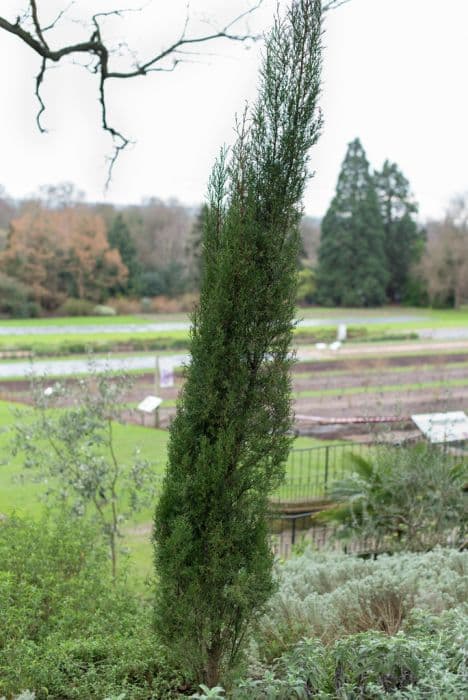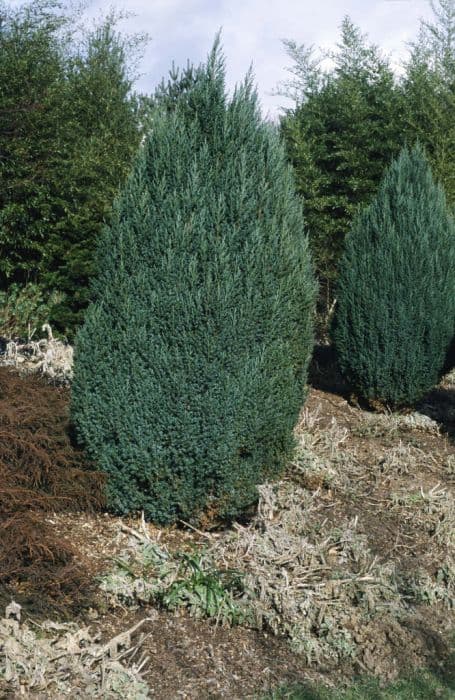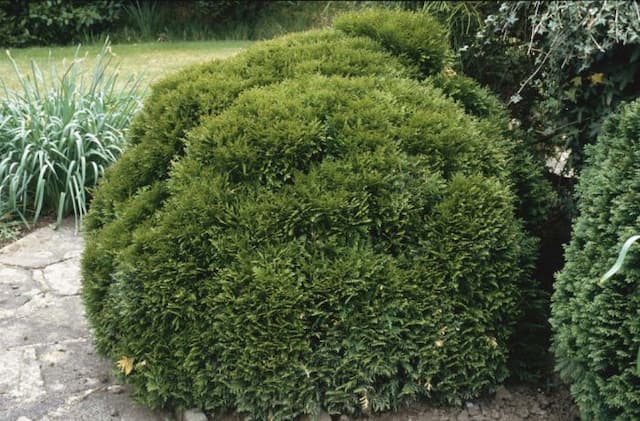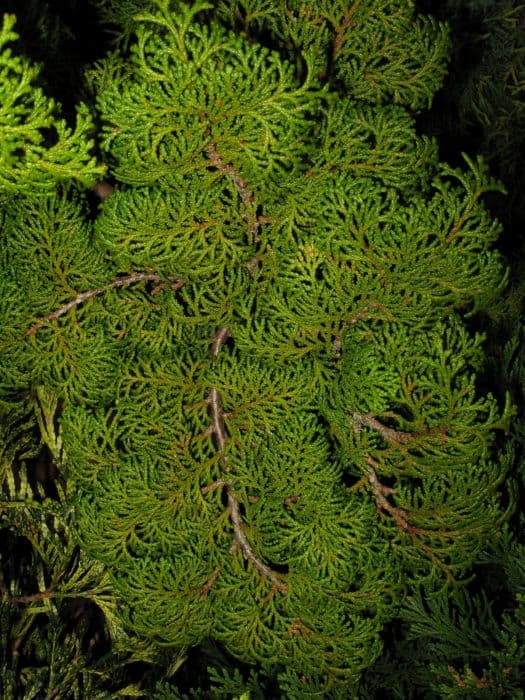American arborvitae Thuja occidentalis 'Holmstrup'

ABOUT
The Thuja occidentalis 'Holmstrup', also known as the American Arborvitae 'Holmstrup', has a distinctive appearance, characterized by its lush, evergreen foliage that maintains a vibrant green color throughout the year. The leaves of this plant are arranged in a scale-like fashion, closely overlapping each other, which contributes to its dense, textured look. Its overall shape is naturally conical, tapering gently to a point at the top, giving it a neat, compact appearance. The foliage of the 'Holmstrup' may exhibit a slight color variation with hints of yellow-green, especially during the colder months, but it largely retains its deep green hue. The branches are closely spaced, ascending upwards and contributing to the plant’s sturdy and uniform silhouette. This cultivar has a reputation for being hardy and resilient, often used in landscaping for its attractive form and year-round interest. It can serve as a specimen plant, be part of a hedge, or act as a windbreak, depending on how it is utilized in the garden. The American Arborvitae 'Holmstrup' produces small, inconspicuous cones that are typically not a prominent feature when admiring the plant. It is also known for its aromatic foliage, which, when crushed or brushed against, releases a pleasant woodsy scent that adds another layer of sensory appeal to its presence in a landscape setting. Overall, the 'Holmstrup' is cherished for its sculptural quality and ease of maintenance, making it a popular choice among gardeners and landscapers.
About this plant
 Names
NamesFamily
Cupressaceae
Synonyms
Eastern Arborvitae, Northern White Cedar, American Arborvitae, Eastern White Cedar, Arborvitae
Common names
Thuja occidentalis 'Holmstrup'
 Toxicity
ToxicityTo humans
The common name for Thuja occidentalis 'Holmstrup' is Arborvitae. Arborvitae is considered to have a certain level of toxicity to humans if ingested. The plant contains compounds such as thujone, which can be harmful if consumed in large quantities. Symptoms of poisoning may include gastrointestinal discomfort, nausea, vomiting, diarrhea, asthma-like reactions, or skin irritation. In severe cases, ingestion can lead to muscular weakness, convulsions, or even seizures. It is advisable to avoid consuming any part of the Arborvitae plant and to supervise children and pets around it.
To pets
The common name for Thuja occidentalis 'Holmstrup' is Arborvitae. Arborvitae is toxic to pets if ingested. It contains compounds that can be harmful, such as thujone, which can affect the nervous system. Symptoms of Arborvitae poisoning in pets can range from gastrointestinal upset, such as vomiting and diarrhea, to more serious neurological symptoms like seizures or muscular weakness. If a pet ingests part of an Arborvitae plant, it is important to seek veterinary attention immediately.
 Characteristics
CharacteristicsLife cycle
Perennials
Foliage type
Evergreen
Color of leaves
Green
Height
5-6 feet (1.5-1.8 meters)
Spread
2-3 feet (0.6-0.9 meters)
Plant type
Shrub
Hardiness zones
2-7
Native area
North America
Benefits
 General Benefits
General Benefits- Low Maintenance: The plant is relatively easy to care for, requiring minimal pruning and attention once established.
- Drought Tolerant: Once established, it is quite resilient to periods of low rainfall, making it suitable for xeriscaping.
- Cold Resistant: This cultivar is hardy in cold climates, making it a good choice for Northern gardens.
- Evergreen Foliage: It retains its foliage throughout the year, providing persistent greenery and color even during winter.
- Privacy Screen: The dense growth habit is ideal for creating living privacy screens or hedges.
- Windbreak: The plant can be used as an effective windbreak, protecting other plants and areas from strong winds.
- Architectural Structure: Its conical shape adds architectural interest to landscape designs.
- Wildlife Habitat: Can provide shelter for birds and other wildlife within its branches.
- Adaptable: It can grow in a variety of soil types, although it prefers well-drained soils.
 Medical Properties
Medical Properties- Thuja occidentalis, commonly known as Northern White Cedar, has been traditionally used for its essential oil which is considered to have expectorant properties, helping to loosen phlegm in the respiratory tract.
- The plant has been used in homeopathy to treat skin conditions such as warts and polyps.
- Its anti-rheumatic properties have been noted, where it has been used to soothe rheumatic pain.
- It has been associated with immunostimulant effects, potentially supporting the body's defense mechanisms.
- Antiviral properties have been observed, particularly in traditional medicine, to tackle certain virus-induced conditions.
 Air-purifying Qualities
Air-purifying QualitiesThis plant is not specifically known for air purifying qualities.
 Other Uses
Other Uses- Woodcraft: The wood of the Arborvitae 'Holmstrup' is soft, making it suitable for carving and small woodworking projects.
- Sound barrier: The dense growth habit of 'Holmstrup' Arborvitae makes it suitable for planting as a sound barrier to reduce noise pollution.
- Privacy hedge: This Arborvitae variety is often used to create tall, dense hedges that can provide privacy in suburban gardens.
- Windbreak: Its sturdy and compact growth habit allows 'Holmstrup' Arborvitae to act as a windbreak, protecting smaller plants and garden areas.
- Erosion Control: When planted on slopes, the root system of 'Holmstrup' can help to stabilize soil and prevent erosion.
- Topiary: The plant can be pruned into various shapes for ornamental purposes, making it a good candidate for topiary gardens.
- Wildlife Shelter: Birds and other small wildlife may use 'Holmstrup' Arborvitae as shelter from predators and inclement weather.
- Cultural Significance: In some cultures, Arborvitae is planted in cemeteries and is associated with eternal life, given its evergreen nature.
- Outdoor classrooms: They can be used in schools for outdoor learning spaces, serving as natural walls for outdoor 'classrooms'.
- Seasonal decoration: Boughs from 'Holmstrup' Arborvitae can be used for holiday decorations such as wreaths and garlands.
Interesting Facts
 Feng Shui
Feng ShuiThe Arborvitae is not used in Feng Shui practice.
 Zodiac Sign Compitability
Zodiac Sign CompitabilityThe Arborvitae is not used in astrology practice.
 Plant Symbolism
Plant Symbolism- Everlasting Life: As an evergreen, the Arborvitae is often associated with immortality or eternal life because it maintains its green foliage throughout the year.
- Protection: The Arborvitae has been traditionally used to create hedges and living fences, symbolizing protection, privacy, and boundary-setting.
- Health: Because of its therapeutic properties and use in traditional medicine, Arborvitae can imply health and healing.
- Privacy: With its dense growth habit, Arborvitae represents the desire for seclusion and private space.
- Resilience: The hardiness and adaptability of Arborvitae to different soil types and environments signify resilience and perseverance.
 Water
WaterThe Arborvitae 'Holmstrup' should be watered regularly, especially during its first growing season to establish a deep root system. Watering should be done in a way that the soil is kept uniformly moist but not waterlogged. After establishment, it can tolerate some dryness but should still receive around 1 inch of water per week during dry periods. During hot weather, you may need to water twice a week, providing about 2 gallons per watering for each shrub, depending on the size and soil conditions.
 Light
LightArborvitae 'Holmstrup' requires full sun to partial shade to thrive. The best spot for this plant is one where it can receive at least six hours of direct sunlight each day, though it can also tolerate light shade. Avoid full shade as it can lead to sparse foliage and a less dense habit.
 Temperature
TemperatureArborvitae 'Holmstrup' can handle a wide range of temperatures and is hardy in USDA zones 3 through 7. It can survive temperatures as low as -40 degrees Fahrenheit and as high as 90 degrees Fahrenheit, but it prefers temperatures between 40 and 75 degrees Fahrenheit. Proper mulching can help to protect the roots in areas with extreme temperatures.
 Pruning
PruningFor Arborvitae 'Holmstrup', pruning is mainly for shaping and removing dead or damaged branches. It's best to prune in the late winter or early spring before the new growth starts. Pruning can be done annually, but excessive pruning should be avoided to maintain the plant's natural cone shape. The best time for pruning is typically between February and April.
 Cleaning
CleaningAs needed
 Soil
SoilThe best soil mix for 'Holmstrup' Arborvitae should be well-draining and loamy with a pH range between 6.0 and 8.0. A mix consisting of garden soil, peat moss, and coarse sand or perlite would be ideal, ensuring proper drainage while still retaining adequate moisture for the roots.
 Repotting
Repotting'Holmstrup' Arborvitae, being a slow-growing conifer, does not need frequent repotting. It should be repotted every 3-5 years or when it is visibly outgrowing its current container. Repot in early spring before new growth starts.
 Humidity & Misting
Humidity & Misting'Holmstrup' Arborvitae thrives in outdoor conditions and doesn't require specific humidity levels, but it enjoys the natural humidity present in the environment. It is quite adaptable to different climates.
 Suitable locations
Suitable locationsIndoor
Grow 'Holmstrup' Arborvitae near a sunny window; water regularly.
Outdoor
Plant 'Holmstrup' Arborvitae in a sunny spot with moist soil.
Hardiness zone
2-7 USDA
 Life cycle
Life cycleThe life of the 'Holmstrup' Eastern Arborvitae begins with seed germination, where the seeds require exposure to cool temperatures for stratification to break dormancy. After sprouting, the seedlings grow into juvenile plants, establishing a root system and developing foliage characteristic of the dense, upright nature of this cultivar. As the plant matures, it enters the vegetative stage, with rapid growth in height and girth, and the foliage becomes a rich green, often developing a narrow pyramidal shape. The 'Holmstrup' typically reaches reproductive maturity after several years, producing small cones that contain the seeds for the next generation. Throughout its life, which can span several decades, the 'Holmstrup' requires minimal maintenance, being resistant to most pests and diseases, and tolerating a range of soil conditions and climates. The plant eventually ages and experiences a decline in vitality, with older specimens showing reduced growth and density, eventually leading to senescence and death.
 Propogation
PropogationPropogation time
Early Spring
The most popular method of propagation for the Eastern Arborvitae 'Holmstrup' is through semi-hardwood cuttings. This is typically done in late summer. Cuttings of about 4 to 6 inches (10 to 15 cm) are taken from the current year's growth. The bottom inch of the cutting is stripped of foliage, and the base is dipped in a rooting hormone to encourage root development. The treated cuttings are then planted in a moist propagating mix and kept under high humidity and indirect light until roots develop. It's important to keep the soil consistently moist but not waterlogged to prevent rot. After rooting, which may take several weeks, the new plants are gradually acclimatized to less humid conditions before being transplanted outdoors.









